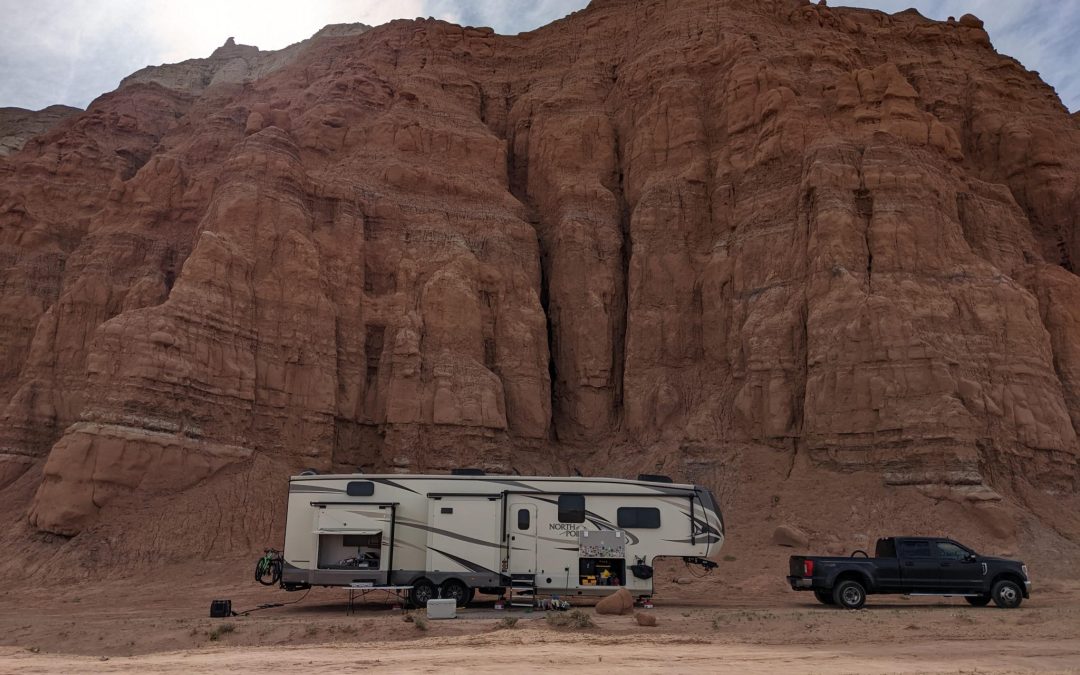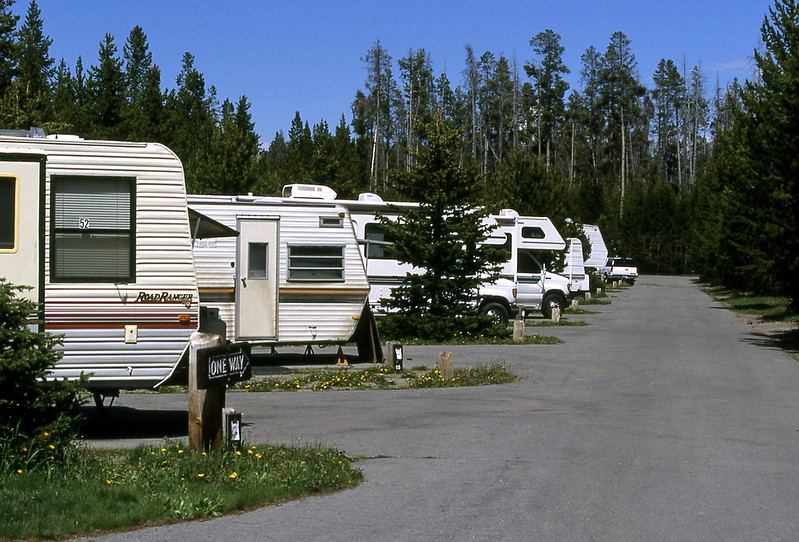Boondocking, also known as dry camping or dispersed camping, is a type of camping where RVers park their vehicles in undeveloped or remote locations for free, without hookups or amenities. Boondocking has gained immense popularity in recent years, with more and more RV enthusiasts choosing this off-the-grid camping option for its adventurous and liberating experience.
What is Boondocking?
Boondocking is a type of camping where RVers park their vehicles in undeveloped or remote locations for free, without hookups or amenities. It is also known as dry camping or dispersed camping. The term “boondocking” originated from the Filipino word “bundók,” which means mountain. Boondocking has been around for decades, but it has gained immense popularity in recent years, especially among RVers who want to explore remote locations and enjoy the peace and tranquility of the great outdoors.
Image Credit: Yellowstone National Park via flickr
Boondocking vs Traditional Camping
Boondocking is different from traditional camping in several ways. Traditional camping usually takes place in established campgrounds that provide amenities such as electricity, water, and sewer hookups, restrooms, showers, and fire pits. Boondocking, on the other hand, takes place in undeveloped or remote locations that do not offer these amenities. This type of camping is ideal for RVers who prefer to be self-sufficient and enjoy the challenge of living off the grid.
Types of Boondocking Locations
There are many types of boondocking locations, including national forests, Bureau of Land Management (BLM) land, state and county parks, wildlife management areas, and other public lands. In addition, some private landowners allow boondocking on their property, provided that RVers respect their privacy and follow their rules.
Advantages and Disadvantages of Boondocking
Boondocking offers several advantages, including cost savings, freedom and flexibility, privacy and seclusion, stunning scenery, and unique experiences. RVers who boondock can save money on camping fees, enjoy more privacy and seclusion, and explore remote locations that are not accessible to traditional campers. However, boondocking also has its disadvantages, including the lack of amenities, the need for self-sufficiency, and the potential risks of camping in remote locations.
Why is Boondocking So Popular?
Boondocking has become a popular camping option among RVers for several reasons. One of the main reasons is cost savings. Boondocking is a free camping option, and RVers who boondock can save hundreds of dollars on camping fees. In addition, boondocking offers a sense of freedom and flexibility that is not available in traditional campgrounds. RVers can choose where to park, when to arrive and leave, and how long to stay. Boondocking also offers privacy and seclusion, as well as stunning scenery and unique experiences that are not available in traditional campgrounds.
Enjoying a Safe & Comfortable Boondocking Experience
Boondocking can be a rewarding and enjoyable camping experience, but it also requires planning and preparation. Here are some tips for RVers who want to try boondocking:
- Plan and prepare: Research boondocking locations, check local regulations and restrictions, and make sure your RV is equipped for off-the-grid camping.
- Choose the right location: Look for safe and accessible locations that offer stunning scenery and unique experiences.
- Take safety precautions: Always let someone know where you are going, have a first-aid kit and fire extinguisher, and bring appropriate clothing and equipment.
- Conserve water and energy: Boondocking requires self-sufficiency, so make sure to conserve your resources by taking shorter showers, using energy-efficient appliances, and minimizing waste.
- Dispose of waste properly: Practice Leave No Trace principles by packing out your trash, using designated dump stations for black and gray water, and avoiding dumping waste in the wild.
- Be a responsible boondocker: Respect other campers’ privacy and space, follow local regulations and restrictions, and leave the campsite better than you found it.
Boondocking Etiquette
Boondocking etiquette is essential to ensure that RVers can continue to enjoy this unique camping experience in the future. Here are some tips on how to be a responsible boondocker:
- Leave no trace: Practice Leave No Trace principles by packing out your trash, leaving natural features undisturbed, and avoiding creating new campsites.
- Respect other campers: Be mindful of other campers’ privacy and space, and avoid creating noise and disturbances that may disrupt their camping experience.
- Follow local regulations and restrictions: Be aware of local regulations and restrictions, such as fire bans, off-road restrictions, and camping time limits.
- Don’t overstay your welcome: Avoid overstaying your welcome in a particular location, and move on to a new campsite after a few days.
- Leave the campsite better than you found it: Clean up your campsite before you leave, and consider doing a quick litter pick up in the surrounding area to help keep the wilderness beautiful for others.
Resources
- U.S. Forest Service: National Forests and Grasslands – https://www.fs.usda.gov/ This website provides information about national forests and grasslands where boondocking is often allowed.
- Bureau of Land Management (BLM) – https://www.blm.gov/ The official website of the Bureau of Land Management provides information about public lands, including BLM lands where boondocking is permitted.
- Recreation.gov – https://www.recreation.gov/ Recreation.gov is a comprehensive resource for finding information about federal recreational activities and outdoor adventures, including boondocking opportunities.
- Campendium – https://www.campendium.com/ Campendium is a popular website that provides reviews, photos, and information about various boondocking locations, including public lands and private properties.
- Leave No Trace Center for Outdoor Ethics – https://lnt.org/ This website offers guidelines and principles for responsible outdoor recreation, including boondocking etiquette and how to minimize the impact on the environment.
FAQs
Q1: What is Boondocking?
A1: Boondocking, also known as dry camping or dispersed camping, is a type of camping where RVers park their vehicles in undeveloped or remote locations for free, without hookups or amenities.
Q2: How is Boondocking different from traditional camping?
A2: Boondocking is different from traditional camping in that it takes place in undeveloped or remote locations that do not offer amenities such as electricity, water, and sewer hookups, restrooms, showers, and fire pits.
Q3: What are the advantages and disadvantages of Boondocking?
A3: Boondocking offers cost savings, freedom and flexibility, privacy and seclusion, stunning scenery, and unique experiences. However, it lacks amenities, requires self-sufficiency, and presents potential risks of camping in remote locations.
Q4: Why has Boondocking become so popular?
A4: Boondocking has become a popular camping option among RVers because it offers cost savings, a sense of freedom and flexibility, privacy and seclusion, stunning scenery, and unique experiences that are not available in traditional campgrounds.
Q5: What are some tips for enjoying a safe and comfortable Boondocking experience?
A5: To enjoy a safe and comfortable Boondocking experience, it is essential to plan and prepare, choose the right location, take safety precautions, conserve water and energy, dispose of waste properly, and be a responsible boondocker by following boondocking etiquette.
Q6: Where can I camp for free?
A6: You can camp for free in various locations known as boondocking sites. They are typically located in undeveloped and remote areas, including public lands managed by the Bureau of Land Management (BLM), National Forests, and grasslands. Many free camping sites can be found through resources like the BLM’s website, Freecampsites.net, Campendium, and various boondocking forums. However, it’s important to check local regulations and confirm that camping is allowed before setting up camp.
Takeaway
Boondocking is an adventurous and liberating experience that offers RVers a unique camping experience that is not available in traditional campgrounds. This off-the-grid camping option provides cost savings, freedom and flexibility, privacy and seclusion, stunning scenery, and unique experiences that are worth trying. However, boondocking also requires planning, preparation, and responsible behavior to ensure a safe and comfortable camping experience. By following these tips and practicing good boondocking etiquette, RVers can enjoy the ultimate RV camping experience that boondocking offers.
Featured Image: CCO licensed photo by Evan Mullins from the WordPress Photo Directory.


